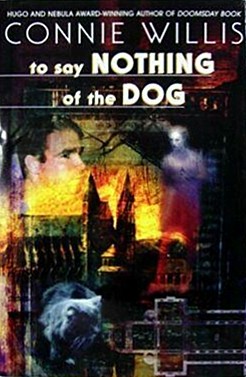Plot
Ned Henry is a time traveler in 1940 studying Coventry Cathedral after the Coventry Blitz of World War II. He is specifically searching for the location of the "Bishop's bird stump", a MacGuffin that is not defined by the narrator. The narrator shows confusion explained by "time-lag", the time-travel-induced form of jet lag. He returns, unsuccessful, to his time, 2057, at Oxford University.
The Bishop's bird stump is needed for a restoration of the cathedral funded by Lady Schrapnell, a wealthy American neo-aristocratic woman with a will of iron. She has conscripted most of Oxford's history department to rebuild the cathedral exactly as it was before it was destroyed. Before going on further trips Ned must recuperate from his time lag and is sent to the hospital. Lady Schrapnell, however, insists he goes back on another trip. Before he can be conscripted by Schrapnell, Professor Dunworthy (who is in charge of the time machine) decides to send him back to the Victorian Era, specifically 1888, for his rest.
Dunworthy has an ulterior motive in sending him to 1888, as another time traveler appears to have violated the laws of the continuum by bringing an object back from then to 2057. Theoretically, nothing may be brought through the time machine in either direction as it might cause time to unravel, and safeguards have been put in place in order to prevent significant objects from making the journey. The historians and scientists who invented the time machine believe the object may rip time itself apart if it isn't promptly returned.
Ned, who only knows 20th century history, and still suffering from time lag, is given a crash course on Victorian times while simultaneously being told his mission and destination. The combination of muddled lessons, imprecise instructions, and the jump to 1888 worsening the time lag leaves him confused about where he is supposed to be, who he should meet, where he should go, and no idea at all about the out-of-time object he is carrying.
Time travel has a self-correcting mechanism called slippage, moving time travelers either in time or place from their target in order to protect history. Ned arrives at the correct time, but unknown to him, he is not at the estate where another time traveler should meet him. Instead, he has slipped in destination to a railway station 30 miles away. He meets Terence St. Trewes, a besotted young Oxford undergraduate, mistaking him for his time travel contact. He agrees to share the cost of a hired boat for a trip on the River Thames from Oxford down to Muchings End, where Terence hopes to meet his love, Tocelyn "Tossie" Mering. Ned, Terence, Cyril the bulldog and Professor Peddick (an Oxford don) travel down the Thames navigating locks, beautiful scenery, crowds of languid boaters in no hurry to get anywhere, and the party of Jerome K. Jerome, a homage to the original novel from which To Say Nothing of the Dog draws its name and themes.
Fortunately, Ned's contact in Muchings End recognizes him when he arrives and identifies herself: she is a young woman named Verity Kindle, who is pretending to be Tossie's cousin. Lady Schrapnell sent Verity to read Tossie's diary because Tossie (an ancestor of Lady Schrapnell) had written about a life-changing event involving the bird stump at the first Coventry Cathedral (St Michael's Cathedral), an event which had caused her to elope with a mysterious "Mr. C" to America. It is only at this point that Ned learns the nature of the object he is to return is Tossie's pet cat, Princess Arjumand. Cats are extinct in 2057 due to a feline distemper pandemic.
Ned and Verity continually attempt to fix the time travel incongruity. They must know the histories of the characters around them, and their descendant's impact on future history, and also the mystery of Mr. C. Their interloping attempts to fix the known history of the people around them cause ripple effects forward and backward through history from Waterloo to World War II, and even to 2018 (when time travel was invented). After several adventures attempting to correct things themselves, both end up, mistakenly, in different eras attempting to get back to 2057. In their absence, time itself corrects their meddling. On their return to 1888, Mr. C has been identified, interrupted relationships between characters have occurred, and clues throughout their experience reveal the location of the Bishop's bird stump in 2057.
Finally, in 2057, just in time for the celebration of the cathedral reconstruction, the location of the Bishop's bird stump proves to the historians and scientists that, in certain scenarios, objects can be brought forward in time which heralds a renaissance in recovery of historically lost, destroyed, or extinct objects.
